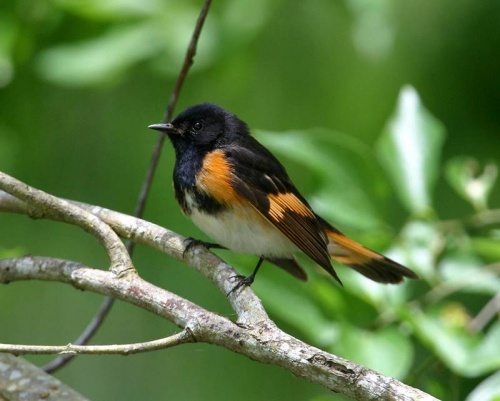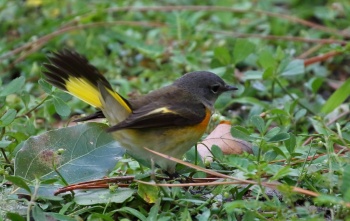- Setophaga ruticilla
Identification
4 1/2-5 1/2" (11-14 cm)
- Elongated Rictal bristles
Male
- Black with bright orange patches on wings and tail
- White belly
Female and young birds: dull olive-brown above, white below, with yellow wing and tail patches.
Distribution
North, Central and South America:
Breeds from Alaska to southern US.
Winters southern US to northern South America and West Indies
Taxonomy
This is a monotypic species[1].
Habitat
Swampy and mixed woodlands, thickets and copses
Behaviour
Fans its tail from side to side when perched.
Diet
Their diet consists almost entirely of insects. They do eat some seeds and berries in the late summer and winter, when on migration.
Breeding
Four white eggs, speckled brown, are laid in cup-shaped nest. The nest is made of grass, bark shreds, plant fibers, and spiderweb and lined with fine grass and hair. The nest is placed in the fork of a tree.
Vocalisation
Five to six high-pitched notes or 2-note phrases. It ends with an upward or downward inflection: chewy-chewy-chewy, chew-chew-chew.
References
- Clements, J. F., T. S. Schulenberg, M. J. Iliff, D. Roberson, T. A. Fredericks, B. L. Sullivan, and C. L. Wood. 2017. The eBird/Clements checklist of birds of the world: v2017, with updates to August 2017. Downloaded from http://www.birds.cornell.edu/clementschecklist/download/
- Boreal Songbird Initiative
- Handbook of the Birds of the World Alive (retrieved Oct 2017)
Recommended Citation
- BirdForum Opus contributors. (2025) American Redstart. In: BirdForum, the forum for wild birds and birding. Retrieved 13 May 2025 from https://www.birdforum.net/opus/American_Redstart
External Links
GSearch checked for 2020 platform.1






